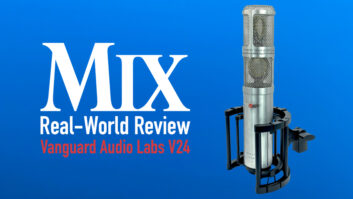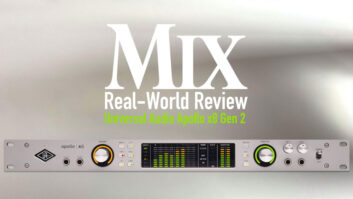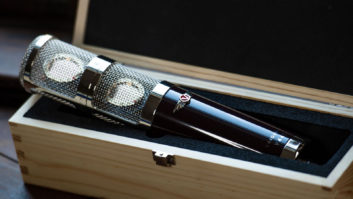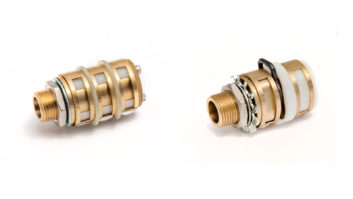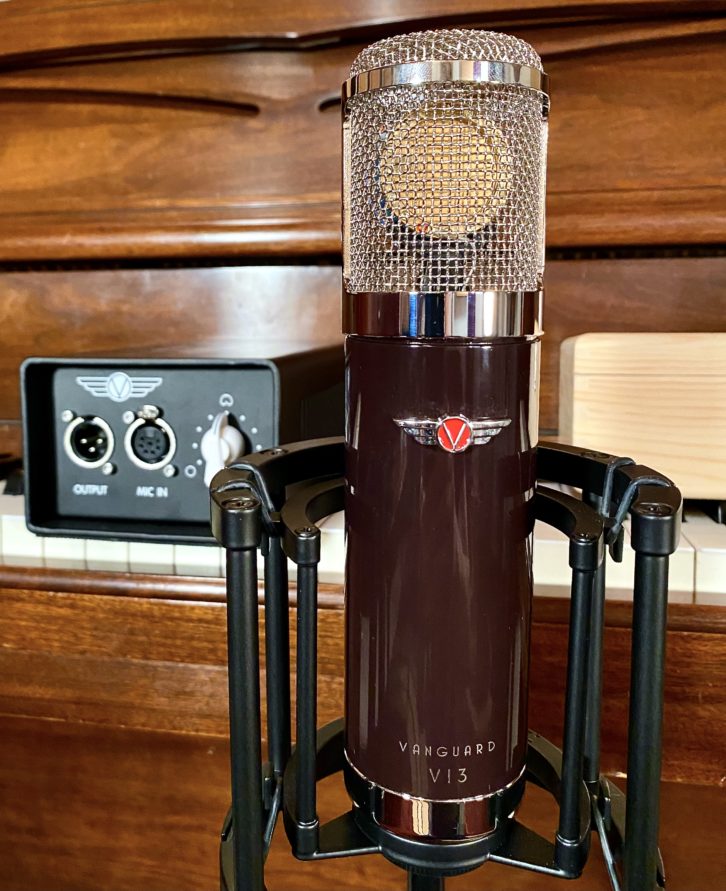
I’ll admit out front that I’ve long been an admirer of Vanguard Audio Labs and the company’s microphones. I’m an endorser of their V1S+LOLLI stereo mic kit and had a good experience in reviewing the original V13. Nonetheless, I’m no fanboy, so I still brought ample amounts of cynicism and curiosity in approaching the new V13 gen2, wondering how it might be “improved” without decreasing the original’s utility or quality of tone.
All of the original V13’s defining traits remain: the slim cylindrical shape, pretty pinot noir finish, open-weave chrome head basket, external power supply, and the U-shaped shock mount (for mounting very close to the source). Component-wise, things remain consistent, or improved upon, as Vanguard has found new sources for a number of parts, an increasingly typical trend in post-pandemic supply chains.
All of Vanguard’s gen2 models continue to use cryogenically frozen components (to increase lifespan, as well as consistency), but audiophile-grade resistors are now USA-sourced, with new interconnects from Neutrik.
The V13 gen2 also has an upgraded power supply, with nine patterns, more headroom, less noise, 110 – 240 V, a 34 mm dual-capsule (Mylar, edge-terminated, gold-sputtered, hand-tune) a European tube (exact model unknown) and a custom-wound, dual-bobbin output transformer.
The sum of these parts manifests in the lowest self-noise of any tube mic (-13 dB, A-weighted) and in its durability, as evidenced by a five-year warranty. Specs include 134 dB SPL handling, 200- ohm output impedance, and 20 Hz – 20 kHz frequency response (deviation unknown).
The V13 gen2 still has a -10 dB pad and high-pass filter at 125 Hz, both with switches on the rear of the mic. Accessories include the shockmount and power supply, 7-pin cable, IEC power cable, pine wood mic box, mic sock and a locking black aluminum carrying case. The V13 gen2 kit seems like a lot for $999.
GUITAR, VOCALS, DRUMS
Without hesitation, I threw the V13 up there for some male vocals; no pad, high-pass filter engaged, and one-click-toward-omni for a wide-cardioid polar pattern. Within a couple of lines of singing, I knew that I was happy with the V13, as there was no noticeable tube-mic sag, darkness or noise, while it did exhibit plenty of good (non-overbearing) sibilance, strong and present mids (if not quite mid-forward) and just the right amount of chestiness with the singer about four inches back and getting some proximity effect.
A Millennia-Media STT-1 mic channel provided clean gain and just a little transformer color, but no EQ was needed and some optical compression made for a very nice vocal sound.
Next up, I tried the V13 as a room mic for drums, right alongside my usual AEA ribbon, with an omni pattern and no pad or filter. The V13 was bright, but also full in the low-mids and lows, with a lot more cymbal detail and crisp attack than you might expect. Mounted about six feet from the loud kit, there was no sign of overload or distortion, even without the pad.
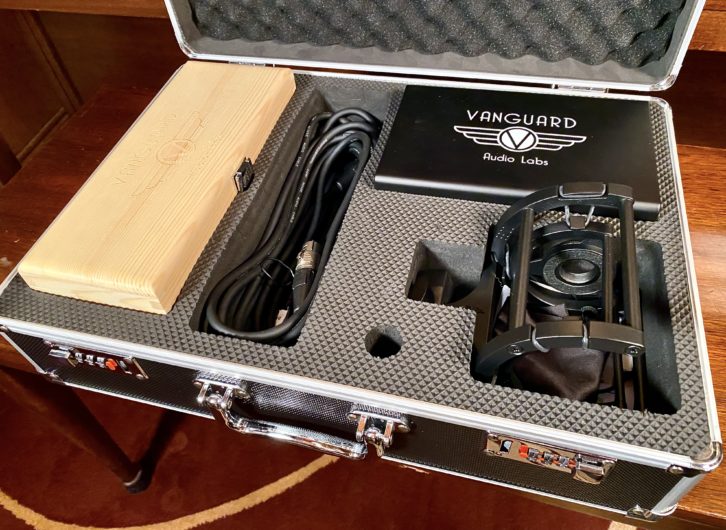
Electric guitar always provides an informative measure of a LDC mic, as many will sound downright fizzy and irritating, with trouble handling the SPL or an inability to get close to the grille cloth, where I like to get in tight for some proximity effect. The V13 sounded quite good, with naturally balanced mids, lots of top-end but not too much, and bottom-end that picked up the benefits of up-close mounting with the U-shaped shockmount.
Acoustic guitar is a really strong app for the V13, where its inherent balance works in a number of placement positions. Capturing the body of the guitar—below and behind the bridge area—yielded fullness and warm resonance; miking right at the neck/body juncture got a pleasantly crisp and string-y defined tone, and positioning it a couple of feet back allowed some air in, with still plenty of closeness and intimacy.
Flock Audio Patch LT – A Real-World Review
Doing the singer/songwriter thing, I then tried the V13 on vocal, where there was more guitar spill than I would like, but the bleed was smooth enough to not be a major problem. This worked fine with a strong singer, though on a quiet, whispery one, it was more problematic, and needed heavy de-essing as well.
Group vocals proved another strong application for the V13. I tried multiple combinations—a group in a circle with an omni pattern, a duo singing harmonies in unison in figure-8 and a small group in cardioid—and got easy-to-mix results. The EQ balance was “right” with all combos, the soundstage was big and the dynamics were naturally open. Best of all was the resultant tone, with lots of stacking. Sometimes a condenser mic’s harshness doesn’t really show up until you’ve built-up a large vocal stack, but here, the V13 remained pleasant in that crucial 2.5–8 kHz range.
I also tried the V13 in omni as a center overhead and got cool-sounding results with some optical compression (with beefy Carnhill transformers). The balance was thick, chunky and saturated enough to contribute to the kick/snare/toms sound, as well as cymbals. On the same drum kit, I did finally find one V13 app that didn’t work for me, as outside-kick was a little too woofy, thick and dirty for my tastes, even with the pad engaged.
FLUTE AND PIANO
I found myself with the rare opportunity to record some solo flute. I wasn’t sure if the V13 would be ideal, as small-diaphragm condensers often prove more focused for such work. The V13 ended up getting the gig, as it lent a little bit of tube fullness to the tone and avoided the thin sterility that some SDCs might bring. Wanting to avoid an unnatural windy bottom end, I chose a pattern one-click-away-from-omni, which provided an open sound, absent of the mechanical noise a cardioid in-close might bring.
Finally, I pulled in pianist extraordinaire Alex Pogosov for some piano tests, listening for fidelity within all that harmonic complexity, dynamics and frequency response. With the V13 mounted two-and-a-half feet above the center of my Yamaha upright, I ran through the options—lid open, lid closed, omni and cardioid.
The V13 sounded fantastic, with a flatness and honesty to the midrange frequencies that was notably accurate and quite musical; no harshness on the high keys (except for one intense percussive trill) and a fullness to the bass that was euphonic and big without being bloated. Omni sounded just like being there, and cardioid sounded a little more focused, but both tones were impressive and begged the question: How good might two V13 gen2 mics sound on piano?
THE FINAL MIX
By now you must be wondering how the V13 gen2 compares to the gen1 sonically. Well, I didn’t have both on hand for direct A/B comparison, but I can say with confidence that the differences are minimal. The gen2 seems to have a little more openness and clarity. Sure, the gen2 top end may be a little silkier, but there’s also a touch more accuracy through the low-mids that contributes to such definition and realism. On certain singers, the gen1 seemed a little weighty in the 200–350 Hz low-mids, and I never experienced that even once with the gen2. The V13 gen1 is certainly no slouch, but I favor the gen2 in all the apps that I tried.
The V13 gen2 is simply a fantastic mic with smart design, quality construction, nearly limitless versatility and a balanced tone that seems to slightly flatter just about any source. I can recommend the V13 as “your first top-shelf mic” for its price/performance ratio, or as an addition to “complete mic closets.” It might soon be your favorite vocal mic, bar none. Vanguard has hit the bullseye with this one, as the V13 gen2 checks all the boxes of performance, affordability and quality in what might just be the best overall workhorse-of-a-mic that I’ve tested to date.
PRODUCT SUMMARY
COMPANY: Vanguard Audio Labs
PRODUCT: V13 gen2 tube microphone kit
WEBSITE: www.vanguardaudiolabs.com
PRICE: $999
PROS: Excellent build quality, versatile features, universal vocal tone, excellent value for the money.
CONS: Doesn’t sound great on kick drum.

